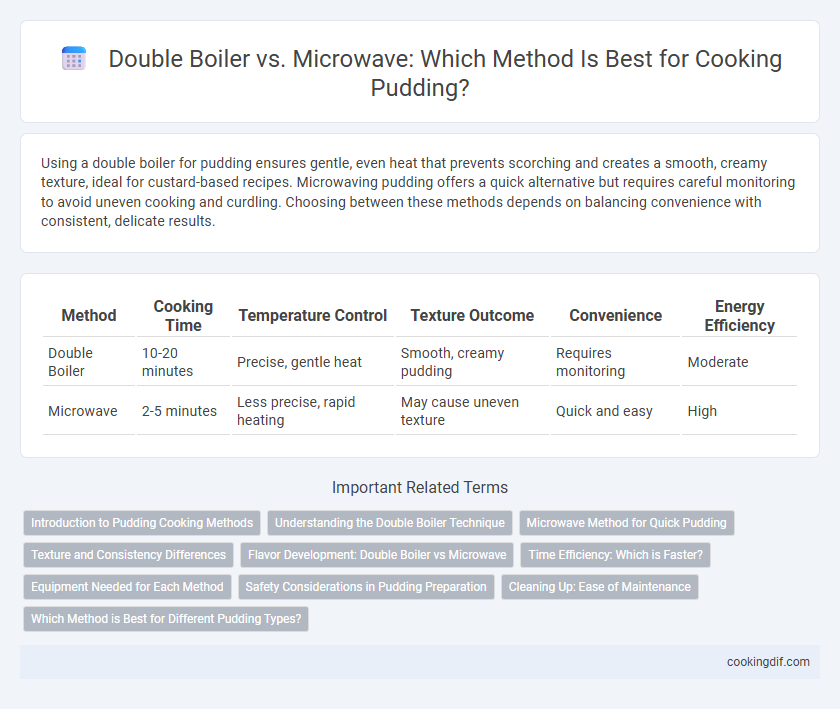Using a double boiler for pudding ensures gentle, even heat that prevents scorching and creates a smooth, creamy texture, ideal for custard-based recipes. Microwaving pudding offers a quick alternative but requires careful monitoring to avoid uneven cooking and curdling. Choosing between these methods depends on balancing convenience with consistent, delicate results.
Table of Comparison
| Method | Cooking Time | Temperature Control | Texture Outcome | Convenience | Energy Efficiency |
|---|---|---|---|---|---|
| Double Boiler | 10-20 minutes | Precise, gentle heat | Smooth, creamy pudding | Requires monitoring | Moderate |
| Microwave | 2-5 minutes | Less precise, rapid heating | May cause uneven texture | Quick and easy | High |
Introduction to Pudding Cooking Methods
Pudding cooking methods commonly involve either a double boiler or a microwave, each offering distinct advantages for achieving smooth, creamy textures. The double boiler uses gentle steam heat to prevent scorching and ensure even cooking, ideal for delicate custards and traditional puddings. Microwaves provide a faster, more convenient option, though they require careful monitoring to avoid uneven heating or curdling.
Understanding the Double Boiler Technique
The double boiler technique involves gently heating pudding ingredients by placing a bowl over simmering water, ensuring even heat distribution and preventing direct contact with the heat source. This method preserves the pudding's creamy texture and reduces the risk of curdling or scorching compared to microwave cooking. Understanding how steam heat gently cooks the pudding is essential for achieving smooth, custard-like consistency without overcooking.
Microwave Method for Quick Pudding
Microwaving pudding offers a rapid cooking method that preserves smooth texture by evenly heating the mixture in short intervals, preventing curdling. This technique reduces preparation time significantly compared to the double boiler, which relies on gentle, indirect heat to avoid burning but requires constant stirring. For convenient, quick pudding preparation, the microwave method is ideal, especially when using microwave-safe bowls and stirring regularly for consistent results.
Texture and Consistency Differences
Using a double boiler for pudding ensures gentle, even heat distribution, producing a smooth, creamy texture with consistent thickness throughout. Microwave cooking often causes uneven heating, which can lead to patchy curdling or a grainy consistency, compromising the pudding's silky finish. The controlled environment of a double boiler enhances the pudding's delicate structure, maintaining ideal firmness without overcooking.
Flavor Development: Double Boiler vs Microwave
Cooking pudding using a double boiler enhances flavor development by providing gentle, even heat that prevents scorching and promotes smooth texture. Microwave cooking heats pudding rapidly but can cause uneven temperature distribution, potentially leading to inconsistent flavor and texture. For rich, well-developed pudding flavors, the controlled heat of a double boiler is preferred over the quick microwave method.
Time Efficiency: Which is Faster?
Microwave cooking significantly reduces pudding preparation time, often completing in 3 to 5 minutes compared to the 15 to 20 minutes required using a double boiler. The double boiler method provides gentle, even heat that prevents scorching but demands continuous attention and slower cooking. For quick pudding preparation, microwaving offers superior time efficiency without compromising texture when carefully timed.
Equipment Needed for Each Method
Cooking pudding in a double boiler requires a heatproof bowl, a pot, and water to create gentle, even steam heat that prevents scorching. Microwave pudding preparation needs a microwave-safe bowl and a microwave oven, allowing for rapid and convenient cooking but requiring careful timing to avoid overcooking. Each method offers distinct equipment advantages, with the double boiler emphasizing controlled heat and the microwave providing speed.
Safety Considerations in Pudding Preparation
Using a double boiler for pudding preparation ensures gentle, controlled heat that minimizes the risk of scorching and overheating, preserving the pudding's smooth texture and preventing dangerous steam burns. Microwave cooking requires careful monitoring to avoid uneven heating, which can cause sudden boiling and splattering, posing burn hazards. For optimal safety, double boilers offer consistent temperature regulation, reducing the risk of accidents during pudding preparation.
Cleaning Up: Ease of Maintenance
Using a double boiler for pudding preparation offers straightforward cleaning because its components--usually two nested pots--are dishwasher safe and do not retain stubborn residues. In contrast, microwave cooking often involves using single-use containers or uneven heating spots that can lead to stubborn food buildup, requiring more intensive scrubbing. The double boiler's smooth surfaces minimize residue adherence, making cleanup faster and less labor-intensive compared to the microwave's potential for uneven spills or splatters.
Which Method is Best for Different Pudding Types?
Using a double boiler provides gentle, even heat ideal for custard-based and delicate puddings like creme brulee and chocolate pudding to prevent curdling or scorching. Microwaving suits quicker preparation of simpler, starch-based puddings such as rice pudding or instant varieties, but requires careful timing to avoid uneven cooking. Selecting the best method depends on pudding texture and ingredients, where double boilers excel in precision and microwaves deliver speed.
double boiler vs microwave for pudding cooking Infographic

 cookingdif.com
cookingdif.com